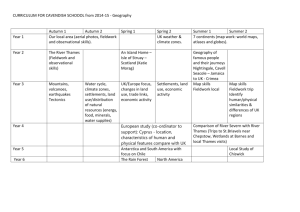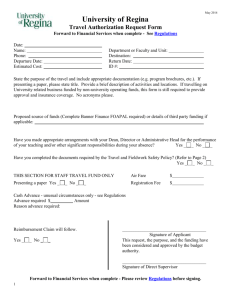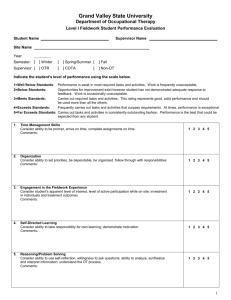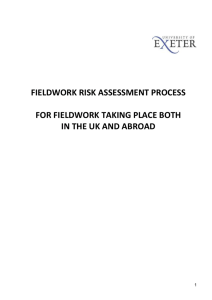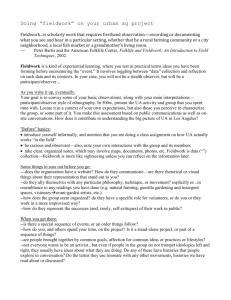Risk Assessment Form for Ecological Fieldwork
advertisement
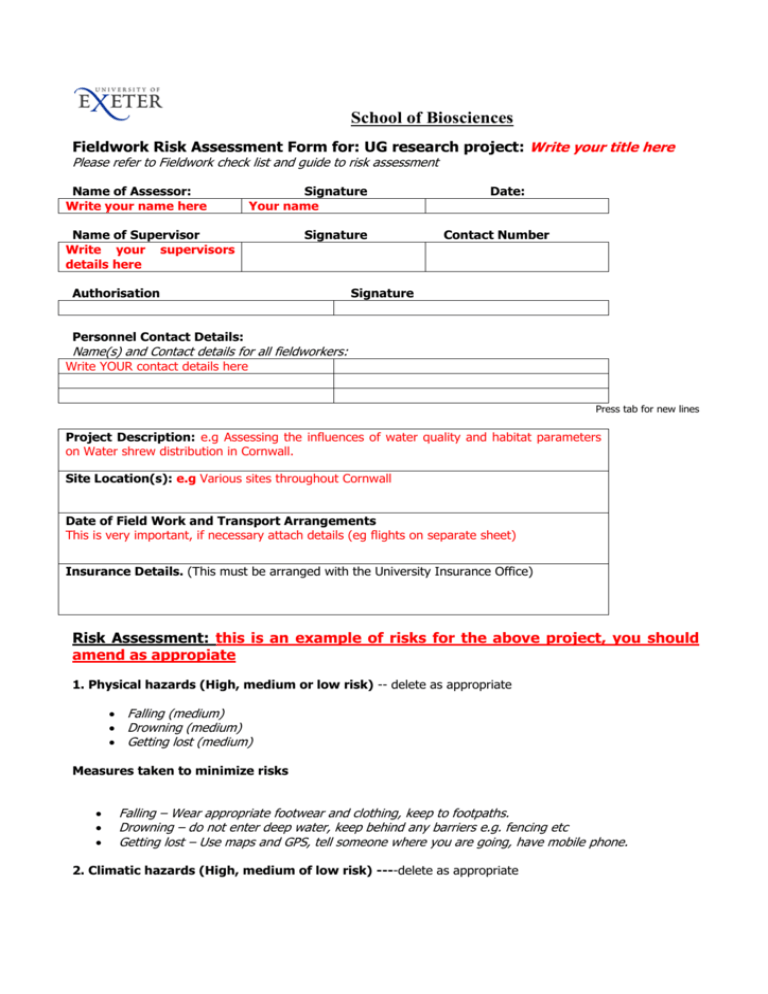
School of Biosciences Fieldwork Risk Assessment Form for: UG research project: Write your title here Please refer to Fieldwork check list and guide to risk assessment Name of Assessor: Write your name here Signature Your name Name of Supervisor Write your supervisors details here Signature Authorisation Date: Contact Number Signature Personnel Contact Details: Name(s) and Contact details for all fieldworkers: Write YOUR contact details here Press tab for new lines Project Description: e.g Assessing the influences of water quality and habitat parameters on Water shrew distribution in Cornwall. Site Location(s): e.g Various sites throughout Cornwall Date of Field Work and Transport Arrangements This is very important, if necessary attach details (eg flights on separate sheet) Insurance Details. (This must be arranged with the University Insurance Office) Risk Assessment: this is an example of risks for the above project, you should amend as appropiate 1. Physical hazards (High, medium or low risk) -- delete as appropriate Falling (medium) Drowning (medium) Getting lost (medium) Measures taken to minimize risks Falling – Wear appropriate footwear and clothing, keep to footpaths. Drowning – do not enter deep water, keep behind any barriers e.g. fencing etc Getting lost – Use maps and GPS, tell someone where you are going, have mobile phone. 2. Climatic hazards (High, medium of low risk) ----delete as appropriate Hypothermia (medium) Hyperthermia (Medium) Sun stroke (Medium) Measures taken to minimize risks . Hypothermia – Wear warm, waterproof clothing (hat, coat, gloves etc), take food and warm drinks in back pack out into the field Hyperthermia – Wear appropriate clothing for the weather – Sun protection: sun hat, sun cream etc... carry drinks and food. Sunstroke- wear sun protection, carry food and drink. 3. Anthropogenic hazards (high, medium or low risk)-- delete as appropriate Is the work likely to cause suspicion or resentment of the public, farmers, home owners etc. Has relevant permission been received? Working on privately owned land Measures taken to minimize risks Make sure permission is granted to work at all sites Emergency Procedures Phone designated persons (Name of contact) and inform them of any problems or accidents on site. If an accident occurs and fieldworkers are able to deal with the situation themselves, they should alert the local Accident and Emergency Department of the nearest hospital and inform them of the situation and the estimated time of arrival at hospital. If unable to do this then phone the emergency services and give approximate location using GPS or OSNI map. Following this, inform the Fieldwork Supervisor (Your supervisor’s name) that an accident has occurred. Contact designated persons (Name of contact) before and at the end of fieldwork informing those persons that the fieldwork has been completed without problems. First Aid & Safety Arrangements Carry a First Aid kit. Carry a charged mobile phone at all times. Report in when finished survey. Emergency Numbers: Tremough or Streatham Call-in number Name and contact number of Biosciences contact person based in the School (ideally from your group) Biosciences department (Tremough) (0)1326 371800 Write the name and number of your ‘Buddy’ contact here Local District Conservation Office (or equivalent) Contacts Name and contact number of local DCO Local Contacts Name and contact number of local personnel Hospitals Names and contact numbers of local and regional hospitals or other health centres School of Biosciences Declaration of Compliance I have read and fully understood the Fieldwork Risk Assessment and acknowledge having done so: I declare that I have read the School's Field Code of Practice and will abide by the instructions contained therein: CODE OF CONDUCT Members of fieldwork groups should be aware that they will be regarded as representatives of the University by locals and other people encountered, and any unsociable or offensive behavior will be interpreted accordingly. The School expects that all staff and students participating in field work and also during free periods within fieldwork projects/courses will behave in a manner that will not bring the University into disrepute. I agree to abide by the School's code of conduct: Write your name here I declare that I have received all recommended immunisations for this field work and that I have declared and health issues that may put me or colleagues at risk on this trip: Write your name here Signed fieldworker(s)…………………................................................ ..................................................................................................... .................................................................................................... .................................................................................................... .................................................................................................... .................................................................................................... .................................................................................................... .................................................................................................... .................................................................................................... .................................................................................................... .................................................................................................... Signed fieldwork coordinator………write your supervisors name here.......................... Date.................................................................. THE SCHOOL SUPPORTS THE UNIVERSAL ETHICAL CODE FOR SCIENTIST IN CASE OF EMERGENCY The information given on this form will greatly assist the Emergency Services and allow your family to be quickly informed. This may mitigate the consequences of your injuries and alleviate unnecessary concern. The information you give is voluntary and will be kept safe and treated in the strictest confidence. You may omit to answer any of the questions you wish. Please return to Anna Leonard or Michelle Hares at Tremough *** PERSONAL DETAILS Full Name • your name Home Address• your address Term time: Post Code • Date of Birth • Home Telephone PERSON TO CONTACT IN AN EMERGENCY Name • Address • ................................................................................................................... .............. Post Code • Telephone MEDICAL DETAILS Please specify any medical condition (e.g. asthma, allergies, diabetes, etc)• Please specify any medication you take regularly • Doctor’s Name • Address • Post Code • Telephone ***A copy of this should be provided for all members of field trip March 2008 COLLEGE/UNIVERSITY FIELDWORK HAZARD IDENTIFICATION / RISK ASSESSMENT FORM SECTION ONE:REF. No: ADMINISTRATIVE DETAILS DATE: SCHOOL: Tremough campus REVIEW DATE: (annually?): VALID UNTIL: SITE: Bioscience REMEDIAL ACTION REQUIRED? NO BUILDING: SIGNATURE OF ASSESSOR: your name REMEDIAL ACTION PRIORITY? HIGH MEDIUM LOW SIGNATURE OF SUPERVISOR: PRINT NAME OF ASSESSOR your name PRINT NAME OF SUPERVISOR ROOM: FIELDWORK ACTIVITY: e.g Assessing the influences of water quality and habitat parameters on Water shrew distribution in Cornwall. BRIEF DESCRIPTION: e.g. Collecting habitat and water quality measures at a variety of sites within Cornwall. ESTIMATED No OF STAFF AT RISK: None SECTION TWO ESTIMATED No OF STUDENTS AT RISK: None HAZARD IDENTIFICATION Identify HAZARDS and circle KEYWORDS (HAZARD = something with the potential to cause harm)this is an example for the above fieldwork HAZARDS KEYWORDS Climate: Storm/Rain:- Lightning, Snow/Sleet, Hypothermia, Snow blindness, Wind (blown over), wind chill, Mist/fog/low cloud:- Getting lost, Sun/Heat:- UV exposure, Sunburn, High temperatures, Heat exhaustion, Heat Stroke, Low temperatures:- Hypothermia / Frostbite. Terrain/Location: Uplands:- Loose/falling rocks, Falls, Mudslides, Reduced oxygen, Lowlands (inc. below ground) :Soft ground, Roof fall, Radon, Floods, Oxygen deficient / Poisonous atmospheres, Tropics:- Heat exhaustion, Marine / Coastal:- Currents, Riptides, Abnormal waves, Inland waters, lagoons:- Tides, Flotsam and Jetsam, Quicksand, Loose rocks, Flash floods, Drowning, Sludge pits, Underwater obstacles, Unstable substrate Woodland:- Fire Getting lost Rocky areas:- Falls Chippings, Rock falls, Urban:- Vehicles, Assault, Roads and Railways, Vehicles, Trains, Electricity. Biological: Farm stock:- Bulls, Pigs, Dogs. Flora and fauna:- Poisonous/irritant plants, Fungi, Reptiles, Arthropods, Insects (Bites & Stings), Microbiological:- Weil's Disease, Tetanus, Malaria, Cholera, Typhoid, Lyme Disease, Algal toxins:- Escherichia (E) coli, Campylobacter, Food borne illness, Water-borne infection Wound infection. Chemical: Water pollution, Dumps, Harmful chemicals, Toxic/flammable gases, wastes. Mechanical: Machinery:- Plant Tools / equipment, Entanglement, trapping, crushing, ejected parts, Electrical: Generators, Portable Electrical Equipment, Shock, Fire, Exposed circuits, Differing safety standards, old equipment. Human Activity: Farming:- Forestry Industrial Machinery, Agrochemicals, Vehicles, Felling, Static and mobile machinery, Buildings, Vehicles, Large plant and machines at open cast sites and quarries, Excavations:- Mines, Quarries ("confined spaces") Toxic gas, Drowning, Asphyxiation, Explosive gas mixes, Roof fall / collapse, Hidden shafts, Dead ends, Failure of props/supports, Military Ammunition:- Explosion, Waste disposal, Hazardous materials. Recreation: Hunting / Shooting, Firearms, Climbing, Rock-falls, Horse riding, Collision, Driving:- All Terrain Vehicles (ATV’s) / Off-roaders, Collision, Skiing:- Avalanche. Water sports:- Surfing, Swimming, Body boarding, Jet Skiing, Diving. Work Procedures: Boats:- Sinking, Swamping, blown out to sea, Diving:- Drowning, ‘Bends’, Working at Height (>2 metres), Integrity of Fall Harness, Safety ropes, Access equipment, Lack of training, Gas Cooking / Heating:- CO poisoning, Fire, Burns, Vehicles Collision:- Being struck by, Fuel fires, Loose loads, Hazardous terrain, Crime:- Theft, Violence. Work Abroad: Vehicles, Catering:- Food-borne illness, Water-borne illness, Local factors:- Restrictions on photography, Local (differing) customs / Sense of humour, Sexual harassment, , Health:- Illness, Infection (eg hepatitis and HIV), Accommodation:- Availability, Suitability, Sanitation, Security:- Civil Unrest, International Tension, Armed conflict, Terrorist activity, Criminal Activity (theft & violence). Other Stressors: Accommodation problems, differing expectations, crime, language/communication problems, isolation, remoteness, lack of family/peer support, workload. Stress trauma General: Lone Working Isolation Health Pre-existing conditions Food intolerance/allergy Foot problems Lack of fitness, exhaustion Behaviour: Group dynamics, Relationships, Alcohol related harm. Legal problems Sites of Special Scientific Interest, Conservation areas, etc. SECTION THREE RISK ASSESSMENT RISK = a combination of the likelihood a hazard will cause injury and the severity of the injury Quantify risk for each hazard identified using the following table: Likelihood of injury improbable remote possible probable likely Score A 1 2 3 4 5 Severity of injury Score B 1 2 3 4 5 very minor injury; abrasions / contusions minor injuries; cuts / burns major injuries; fractures / cuts / burns / damage to internal organs severe injury; amputation / eye loss / permanent disability Death Enter Hazards identified in Section 2. Enter Existing control measures. Quantify Risk factor by multiplying Score A and Score B, taking account of existing control measures. If Risk factor is over 5: take Remedial Action (precautions) to improve or increase the number of existing control measures so that risk factor is below 5 . If Risk factor is 5 or under, the risks are under adequate control, but should be continuously monitored. Hazards Existing control measures Hypothermia Hyperthermia Falling Getting lost Appropriate clothing Appropriate clothing Appropriate footwear and clothing Carry Map, Mobile phone, ensure someone knows where you are and time you are expected to return Do not enter deep, fast flowing water, wear appropriate footwear, keep to footpaths, do not cross barriers –fencing etc.... carry mobile phone Appropriate clothing, carry food and water. Drowning Exhaustion Score A Score B Risk (A x B) 1 1 3 1 4 4 1 3 4 4 3 3 1 5 5 1 5 5 Remedial Action HAVE YOU ARRANGED INSURANCE AND/OR NOTIFIED THE UNIVERSITY INSURANCE OFFICE YES / NO DETAILS DATE

